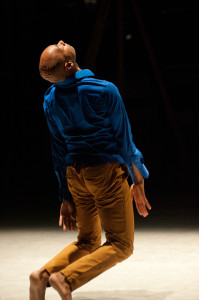In advance of her company’s West Coast premiere of A History January 25 and 26 at the Yerba Buena Center for the Arts (YBCA), Bebe Miller made a visit to San Francisco in November, part of Performing Arts Director Marc Bamuthi Joseph’s intent to extend the artist relationship with the local community and presenting institution beyond the performance run. Among the pre-tour activities, Miller taught at San Francisco State University, shot video around town and also caught up with Bay Area collaborator, dance artist and teacher, Kathleen Hermesdorf.

“I met Kathleen at Bates Dance Festival in the 90s and we hit it off. She’s a fabulous dancer and improviser,” commented Miller. The choreographer says she chooses dancers based on how their personality comes through the movement with awareness that she is forming a community of workers. “I choose dancers who take their performance from their current line of thought.” About half of the artists in A History also make their own work and all of them use improvisation as a strategy.
Since the Bebe Miller Company operates as a virtual company with members living in locations around the United States, new work is developed over a period of years in residencies that bring project collaborators together for creative development and rehearsals. Therefore, Miller prefers to tighten the score of the approach instead of prescribing movement. Rather than memorizing and executing the specifics of an action, the artists develop the skills of what Miller calls “dancing specifically” from a particular nature or line of thought. When reconvening, Miller brings the video from the last rehearsal and the dancers begin by observing.
“Does a company really just show up? In our roles we are witness to being inside a collaborative team. We wanted to reveal that,” notes Miller while discussing A History. The seed of the work surfaced five years ago during a conversation between Miller and her dramaturg Talvin Wilks about privileging the process and studio hours as material. It focuses on the artist relationship between veteran company members Angie Hauser and Darrell Jones over a ten year period. The evening-length duet makes manifest the experience of dance-making and can be seen as both the evidence and performance of artistic creation. To prepare, the company recorded hours of video and audio from rehearsal including conversations, questions, considerations and decision-making. The performers in A History then wear headphones at times to listen to the audio, which captures the nature of the studio. Miller attributes this device to The Wooster Group (also performing at YBCA this spring).
In shifting her archive from artifacts to artwork, Miller acknowledges that her relationship to an archive is distinct from one of an archivist or curator, commenting, “As dancers and makers we have ideas about what should be preserved and presented.” In addition to the archive of materials, performers possess a physical history. “The archive is also the information embedded in their movement,” she adds. Miller keeps journals dating back to the ‘70s and encourages her students to do the same. “It’s good to have a record and always be gathering. At Ohio State University I tell my students to just write everything down. You are your archive. There’s also so much you carry in your own body.”
A History incorporates video by Lily Skove and an accompanying digital media installation of the visual history by Maya Ciarrocchi. Through this work Miller hopes that audiences can experience what dance-making feels like, sounds like and thinks like. Ciarrocchi’s installation was part of a larger exhibition on view August 23-September 30, 2012 at the Wexner Center for the Arts, which included costumes, sets, notation, rehearsal and performance documentation, music, conversations with peers, as well as performed responses to Miller’s work, curated by Jerry Dannemiller, through a project developed at the Institute for Curatorial Practice in Performance.
A History arrives on the heels of other body-as-archive oriented performances in San Francisco. Muriel Maffre’s performance as part of Nina Beier’s The Complete Works (December 4 and 11, 2010 at YBCA) charged the retired ballerina to perform all the roles she ever danced during her professional career as she recalls in chronological order. The work, which was also performed last October at the Tate Modern’s new performance space, The Tanks, required the artist to rely on body and memory as archive from which to draw an entire performance. In addition, Morgan Thorson’s Spaceholder Festival, an evening-length work for six performers at the ODC Theater October 5-7, 2012, thrust the audience into the role of archaeologist considering what happens when the artifact is not a fixed object, but a living human body – always in flux, in a continual state of becoming and deterioration.
By noting some of these works, which pry at the accretion of body memory, one may wonder why the string of vulnerable and self-referential interrogation now? All of these works place value on the labor inherent, yet not always visible, in performance. Work-in-process showings are another version of the desire to privilege the dance thinking and development. Bebe Miller Company’s A History will make public a traditionally hidden process, inviting the audience to experience her art as a group of relationships rather than a closed piece.
Bebe Miller Company’s A History will be presented by the Yerba Buena Center for the Arts, January 25 – 26. ybca.org
This article appeared in the January/February 2013 issue of In Dance.

